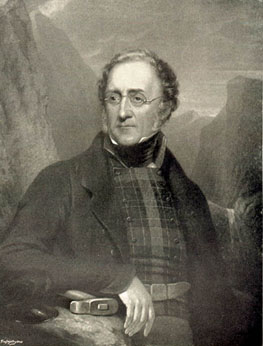| Henry de la Beche  Born: 1796 Born: 1796
Birthplace: London, England
Died: 13-Apr-1855
Location of death: London, England
Cause of death: unspecified
Gender: Male
Race or Ethnicity: White
Occupation: Geologist Nationality: England
Executive summary: Created first Geologic Survey English geologist, born in the year 1796. His father, an officer in the army, possessed landed property in Jamaica. but died while his son was still young. The boy accordingly spent his youth with his mother at Lyme Regis among the interesting and picturesque coast cliffs of the southwest of England, where he imbibed a love for geological pursuits and cultivated a marked artistic faculty. When fourteen years of age, being destined, like his friend Murchison, for the military profession, he entered the college at Great Marlow, where he distinguished himself by the rapidity and skill with which he executed sketches showing the salient features of a district. The peace of 1815, however, changed his career and he devoted himself with ever-increasing assiduity to the pursuit of geology. When only twenty-one years of age he joined the Geological Society of London, continuing throughout life to be one of its most active, useful and honored members. He was president in 1848-49. Possessing a fortune sufficient for the gratification of his tastes, he visited many localities of geological interest, not only in Britain, but also on the continent, in France and Switzerland. His journeys seldom failed to bear fruit in suggestive papers accompanied by sketches. Early attachment to the southwest of England led him back to that region, where, with enlarged experience, he began the detailed investigation of the rocks of Cornwall and Devon. Thrown much into contact with the mining community of that part of the country, he conceived the idea that the nation ought to compile a geological map of the United Kingdom, and collect and preserve specimens to illustrate, and aid in further developing, its mineral industries. He showed his skilful management of affairs by inducing the government of the day to recognize his work and give him an appointment in connection with the Ordnance Survey. This formed the starting point of the present Geological Survey of Great Britain, which was officially recognized in 1835, when De la Beche was appointed director. Year by year increasing stores of valuable specimens were transmitted to London; and the building at Craig's Court, where the young Museum of Economic Geology was placed, became too small. But De la Beche, having seen how fruitful his first idea had become, appealed to the authorities not merely to provide a larger structure, but to widen the whole scope of the scientific establishment of which he was the head, so as to impart to it the character of a great educational institution where practical as well as theoretical instruction should be given in every branch of science necessary for the conduct of mining work. In this endeavor he was again successful. Parliament sanctioned the erection of a museum in Jermyn Street, London, and the organization of a staff of professors with laboratories and other appliances. The establishment, in which were combined the offices of the Geological Survey, the Museum of Practical Geology, The Royal School of Mines and the Mining Record Office, was opened in 1851. Many foreign countries have since formed geological surveys avowedly based upon the organization and experience of that of the United Kingdom. The British colonies, also, have in many instances established similar surveys for the development of their mineral resources, and have had recourse to the parent survey for advice and for officers to conduct the operations.
De la Beche published numerous memoirs on English geology in the Transactions of the Geological Society of London, as well as in the Memoirs of the Geological Survey, notably the Report on the Geology of Cornwall, Devon and West Somerset (5839). He likewise wrote A Geological Manual (1831); and a work of singular breadth and clearness -- Researches in Theoretical Geology (1834) -- in which he enunciated a philosophical treatment of geological questions much in advance of his time. An early volume, How to Observe Geology (1835 and 1836), was rewritten and enlarged by him late in life, and published under the title of The Geological Observer (1851). It was marked by wide practical experience, multifarious knowledge, philosophical insight and a genius for artistic delineation of geological phenomena. He was elected F.R.S. in 1819. He received the honor of knighthood in 1848, and near the close of his life was awarded the Wollaston medal -- the highest honor in the gift of the Geological Society of London. After a life of constant activity he began to suffer from partial paralysis, but, though becoming gradually worse, continued able to transact his official business until a few days before his death, which took place on the 13th of April 1855.
Royal Society 1819
Wollaston Medal 1855
Knighthood 1848
Requires Flash 7+ and Javascript.
Do you know something we don't?
Submit a correction or make a comment about this profile
Copyright ©2019 Soylent Communications
|